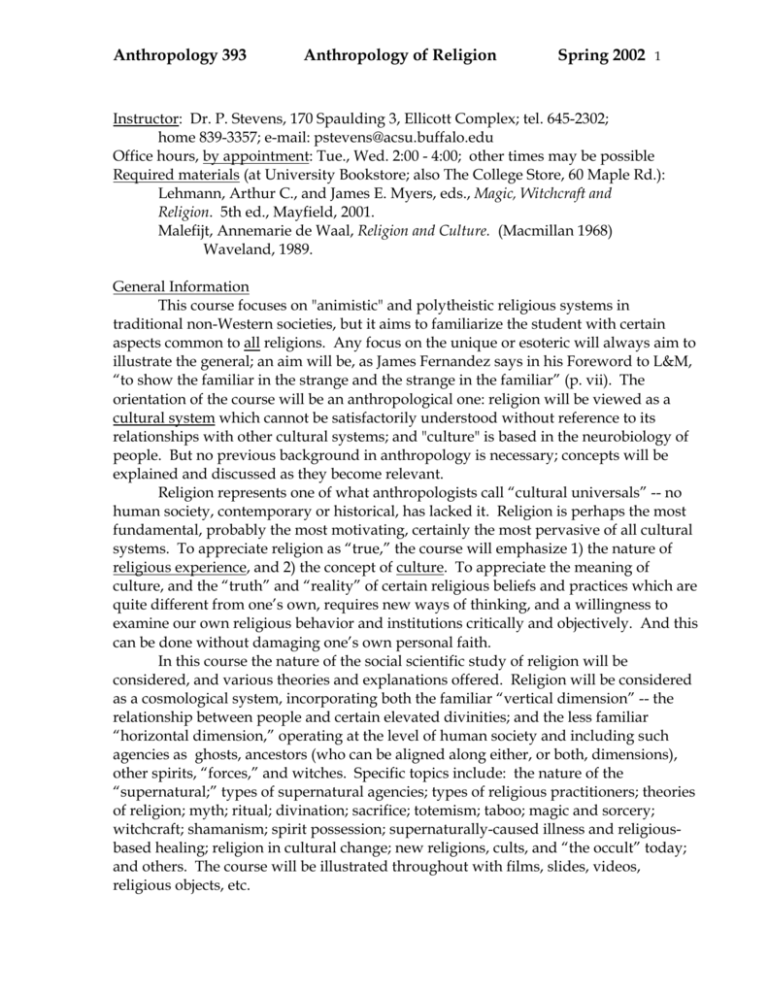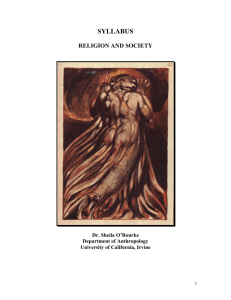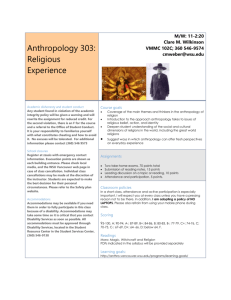The Anthropology of Religion
advertisement

Anthropology 393 Anthropology of Religion Spring 2002 1 Instructor: Dr. P. Stevens, 170 Spaulding 3, Ellicott Complex; tel. 645-2302; home 839-3357; e-mail: pstevens@acsu.buffalo.edu Office hours, by appointment: Tue., Wed. 2:00 - 4:00; other times may be possible Required materials (at University Bookstore; also The College Store, 60 Maple Rd.): Lehmann, Arthur C., and James E. Myers, eds., Magic, Witchcraft and Religion. 5th ed., Mayfield, 2001. Malefijt, Annemarie de Waal, Religion and Culture. (Macmillan 1968) Waveland, 1989. General Information This course focuses on "animistic" and polytheistic religious systems in traditional non-Western societies, but it aims to familiarize the student with certain aspects common to all religions. Any focus on the unique or esoteric will always aim to illustrate the general; an aim will be, as James Fernandez says in his Foreword to L&M, “to show the familiar in the strange and the strange in the familiar” (p. vii). The orientation of the course will be an anthropological one: religion will be viewed as a cultural system which cannot be satisfactorily understood without reference to its relationships with other cultural systems; and "culture" is based in the neurobiology of people. But no previous background in anthropology is necessary; concepts will be explained and discussed as they become relevant. Religion represents one of what anthropologists call “cultural universals” -- no human society, contemporary or historical, has lacked it. Religion is perhaps the most fundamental, probably the most motivating, certainly the most pervasive of all cultural systems. To appreciate religion as “true,” the course will emphasize 1) the nature of religious experience, and 2) the concept of culture. To appreciate the meaning of culture, and the “truth” and “reality” of certain religious beliefs and practices which are quite different from one’s own, requires new ways of thinking, and a willingness to examine our own religious behavior and institutions critically and objectively. And this can be done without damaging one’s own personal faith. In this course the nature of the social scientific study of religion will be considered, and various theories and explanations offered. Religion will be considered as a cosmological system, incorporating both the familiar “vertical dimension” -- the relationship between people and certain elevated divinities; and the less familiar “horizontal dimension,” operating at the level of human society and including such agencies as ghosts, ancestors (who can be aligned along either, or both, dimensions), other spirits, “forces,” and witches. Specific topics include: the nature of the “supernatural;” types of supernatural agencies; types of religious practitioners; theories of religion; myth; ritual; divination; sacrifice; totemism; taboo; magic and sorcery; witchcraft; shamanism; spirit possession; supernaturally-caused illness and religiousbased healing; religion in cultural change; new religions, cults, and “the occult” today; and others. The course will be illustrated throughout with films, slides, videos, religious objects, etc. Anthropology 393 Anthropology of Religion Spring 2002 2 General requirements. Read and understand. Your registration in this course means that you agree to the following stipulations. regular attendance. You can not do well if you don’t attend class, listen carefully, and take notes carefully. The theoretical framework for the course is presented in class. Most of what is given in class is not given anywhere else. If you must miss a class, you must get that material from another (reliable) student. From 1/29 attendance will be taken in every class. Regular attendance will help your grade; irregular attendance will hurt. careful completion of assigned readings, on time. Readings and class lectures are designed to complement each other, not to substitute for one another. Specific reading material will be referred to in class, in its appropriate context. If you fall behind in the readings you might miss the opportunity to discuss them. Tests will cover both class material and assigned readings; you must do both, on time. ( Note: as you read, take separate notes on the general gist of each reading assignment. Do not just mark the text. Understand the author's main points, and illustrate them with two or three substantive examples, which you can get from the readings and from class material. Then compare different readings on similar topics, and readings with lecture material, and organize your notes accordingly.) TESTS are of the short essay and short answer type, given as follows: first test in class Feb. 12. About 10% of course grade. a take-home test, March 14-19. Must be typed, see below. About 30% of course grade. a final test, according to University Final Examination schedule. Covers specific material presented after the second test, and general concepts since the beginning of the course. About 30% of course grade. a term project is required, 10-12 pages, typed (see below). Based either on library research, or a “field” project (details later). Due in class April 30. About 30% of course grade. note: percentages indicated are approximate. The final grade average will be weighted for marked improvement, and/or class attendance. A proposal for the proposed term project is due in class on Thursday, March 14, not later and not earlier. Your proposal should be about 100 words. It should say what you intend to do, and how you intend to do it. You must investigate the feasibility of your project in advance. If you are uncertain about any aspect of it, you should talk to Dr. Stevens by March 5. Details will come later; for now, we can say that the project must be on a topic within the purview of this course, and it must use concepts or methods suggested in the course material. It must be an exercise in the anthropology of religion. It must not be just a report; it must show some analytical thinking. typewritten materials (take-home test and term project) must be double-spaced, on opaque white 8 1⁄2 x 11” paper, typed on one side of a sheet only, with margins of 1” on all sides. Pages should be numbered, and your name should appear on every page. Pages should be stapled together, once, at the upper left corner. You may use a cover sheet, but use no binder of any sort. Anthropology 393 Anthropology of Religion Spring 2002 3 Specific guidelines on conducting your research and constructing the term project will be distributed in early March. Your final paper MUST conform to these guidelines. deadlines. If you absolutely cannot meet a deadline, you must inform Dr. Stevens, in advance, or as soon after the missed deadline as possible. Extensions and/or make-up tests may be granted, depending on circumstances. But, unexcused late papers will lose a lot of credit for every day late. And, make-up tests are a pain, for both of us. Please. Be conscientious. summary of important dates: February 12, TEST I March 14, statement of term project due March 14-19, TEST II April 30, term project due TEST III, according to University Final Exam schedule General Course Outline Students should have a good general understanding of the material in the assigned readings during the week for which they are assigned. Materials should be read in the order in which they are listed. Note that some readings are assigned more than once. Test dates and deadlines are firm; topics, readings, videos, etc., may change. Any changes will be announced in advance. M = Malefijt; L&M = Lehmann & Myers. Week Dates Topics, readings, etc.______________________ 1 T 1/22 Orientation. Our expectations, your obligations. What is religion? The anthropological approach. Religion as a cultural system. Th 1/24 Religious beliefs and their cultural context. The “truth” of religious beliefs. The nature of the “religious experience.” video: “The Madonna of Medjugorje,” a major Catholic pilgrimage site in Bosnia-Herzegovina; in 1981, seven adolescent children experienced visitation by the Virgin Mary. Readings for Week 1 M: Chap. 1 L&M: Miner 82-85; vii-5; Geertz 6-15; Harris 16-19; D. Lee 20-26; R. Lee 399-405; Sharp 27-34; Barkun 114-119. Beginning next week, attendance will be taken in every class. Your record of attendance will affect your final grade. Anthropology 393 Week Dates 2 T 1/29 3 4 Anthropology of Religion Spring 2002 Topics, readings, etc. The concept of supernatural power. The "truth" of religious beliefs, cont'd.: culture, perception and “reality.” The nature of symbols. Th 1/31 Religion as cosmology: the “vertical dimension” of religious beliefs. Priests and shamans. Status and role in religious practice. Readings for Week 2 same as for Week 1, plus M: Chaps. 6, 9 L&M: 37, on symbols; Firth 64-67; 86-88; Turner 89-96; von Furer-Haimendorf 97-101; Howells 102-109. T 2/5 film: “The 11 Powers,” a major once-in-a-century Shivaistic Hindu festival on the island of Bali, Indonesia, addressed to the major deities (manifestations of Shiva) and designed to restore order and harmony to the world. Th 2/7 The “horizontal dimension”of religious beliefs. film: “The Spirit Possession of Alejandro Mamani,” an old man of the Aymara of Bolivia. review questions for TEST I distributed today Readings for Week 3 review all readings to date, plus L&M: Nash 253-258. T 2/12 Th 2/14 TEST I, about 45 minutes, on material through Week 3. after test: religion and society: anthropological theories of religion. Anthropological theories of religion, cont'd. Readings for Week 4 M: 48-55, 58-65, 68-73, 76-80, 81-90; review Chaps. 1, 9; Chap. 12 L&M: 1-5; Geertz 6-15; Turner 89-96; Lindenbaum 304-311. 4 __ Anthropology 393 Week Dates 5 T 2/19 6 7 Anthropology of Religion Spring 2002 5 Topics, readings, etc. ___ Sacred and secular traditions; myth, legend, and folktale. Heroes and Tricksters. Th 2/21 Ritual. Periodic or calendrical rituals; critical rituals. Rituals of reversal/rebellion. The individual life cycle: "rites of passage" Readings for Week 5 M: Chaps. 7, 8, 9 L&M: 35-37; Leach 39-45; Turner 46-55; Gordon 56-63. hand-out: Raglan's Traits of the Hero T 2/26 More on ancestors, ghosts, other spirits. The soul and its options. slides: art of the Australian "Dream Time" Th 2/28 The magical world view. Anthropological considerations of magic and sorcery. Readings for Week 6 M: 12-14, 48-55, 53-55, 63-65, 85-90, 146-149 (on mana); 118-129 (on Upper Paleolithic art) L&M: 300-303; Sharp 27-34; Nash 253-258; Mitchell 312-317; Metcalf 340-343. T 3/5 Variants on the principles of magic: sorcery, mana, taboo, "pollution," divination, magical power symbols, magical protection. Spirit and magic in "New Age" beliefs. Th 3/7 Meanings of "witchcraft." The ethnological/historical meaning. Readings for Week 7 M: Chap. 11 L&M: D. Lee 20-26; 251-252, on magic; Malinowski 287-292; Gmelch 293-299; Hand 197-203; Dubisch 73-81; Stevens 215-223; McPherson 224-232; R. Lee 399-405; Douglas 68-72; Lindenbaum 304-311; Mair 273-280; Evans-Pritchard 281-286. Plan your term project. Statement due 3/14 Anthropology 393 Week Dates 8 T 3/12 Anthropology of Religion Spring 2002 6 Topics, Readings, etc.________________ Witchcraft, cont'd. The Evil Eye. Monsters of the night. The nocturnal attack experience: more neurobiological bases for religious beliefs? Th 3/14 The "Voodoo Death." Defenses against sorcery and witchcraft. The witch and the shaman. Term project statement due in class today. TEST II questions distributed in class today, covers material through Week 8, essays due in class 3/19 Readings for Week 8 L&M: 204-207; Brain 192-198; Barber 318-311; Eastwell 233-242; Levi-Strauss 187-196; review Turner 89-96, Von Furer-Haimendorf 97-101; Howells 102-109; M.F. Brown 110-113. 9 T 3/19 TEST II essays due in class today Religious bases for illness and healing. video: "Bono Medicines," part 1: health and illness, witches and witch catching, and possession among the Bono of central Ghana. Th 3/21 10 video: "Bono Medicines," part 2; Western medicine comes to the Bono. Readings for Week 9 M: Chap. 10 L&M: 86-88, 120-122; deRopp 144-149; Harner 138-143; Levi-Strauss 187196; Kiev 163-167; Bergman 168-172; Wedenoja 173-180; Bass 181-186; Pattison 259-272. Work on your term project. T 3/26, Th 3/28 SPRING BREAK Anthropology 393 Week Dates 11 T 4/2 12 13 Spring 2002 7 Topics, readings, etc._______________ Illness and healing, shamans, cont'd. The question of deception. The "religious experience," again. Religiously significant altered states of consciousness: ecstasy, possession, trance; exorcism. Drugs in RASC's. Th 4/4 video: "Iramudun," possession and exorcism in Sri Lanka. Readings for Week 11 same as for Week 9; review L&M: Howells 102-109; M.F. Brown 110-113; R. Lee 399-405. Work on your term project. T 4/9 videos: "The Exorcism of Gina;" and Lutheran "deliverance" in Minnesota -- demon possession in mainstream America? Th 4/11 film: "Holy Ghost People," spirit possession and snake handling in rural Virginia. Readings for Week 12 L&M: Daugherty 369-374. Work on your term project! T 4/16 Th 4/18 14 Anthropology of Religion Religion among the Bachama of Nigeria Bachama religion, cont'd. Readings for Week 13 No new readings. Work on your term project. T 4/23 Religion in cultural change. Missionaries. Revitalization movements. The concept of the Millennium. "Cults." Th 4/25 Revitalization movements, cont'd. slides: "The Ghost Dance Tragedy at Wounded Knee" Readings for Week 14 M Chap. 13 L&M: 344-347; Sharp 27-34; Wallace 348-353; Kehoe 354-358; Slotkin 130-133; Worsley 359-363; Lewis 364-368. Work on your term project; it's due next Tuesday! Anthropology 393 15 Anthropology of Religion Spring 2002 8 T 4/30 film: "Legacy of the Spirits," Vodoun in New York City. Term Projects due today!!! to be returned at Test III. Th 5/2 Mainstream religion, cults and "the occult" today. video: "The Devil's Disciples," on rumors of killer satanic cults in Canada and the US TEST III, review questions distributed Readings for Week 15 M: Chap. 13 L&M: K.M. Brown 324-329; Puttick 375-380; 381-383; Barkun 114-119; Orion 243-248; Newsweek 406-410; Sagan 384-389; Singer & Benassi 390-398. TEST III, c. 11⁄2 hrs., during Final Exam period:








